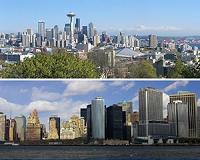 |
Washington DC (SPX) Nov 18, 2010 In early November 2010, the director general of the European Commission's Humanitarian Aid and Civil Protection Department warned that flood water could linger up to six more months in Pakistan. Agence France-Presse reported that evaporation was the only apparent means of removing the water and, depending on depth and climate conditions, evaporation could take months. Large expanses of Pakistan's southern province of Sindh remained inundated in early November. Acquired by the Moderate Resolution Imaging Spectroradiometer (MODIS) on NASA's Terra satellite, these images show parts of the Indus River Valley on November 13, 2010 (top), and November 17, 2009 (bottom). Both images use a combination of infrared and visible light to increase the contrast between water and land. Water ranges in color from electric blue to navy. Vegetation appears bright green. Bare land ranges from pink-beige to brick red. Clouds are pale blue-green. Compared to the image acquired one year earlier, the image from November 2010 shows flooding west of the city of Sukkur, and east of the city of Thatta. Exceptionally heavy monsoon rains caused widespread flooding in Pakistan starting in late July 2010. Most of the flooding occurred along the Indus River, but a dam failure north of the city of Sukkur also sent massive amounts of water west of the river, creating a floodwater lake terminating in Manchhar (or Manchar) Lake. Months after the floodwater lake formed, water levels had fallen somewhat. The lake was far from completely drained, however, leaving settlements and agricultural lands underwater. At the beginning of November 2010, the Red Cross warned that stagnant water increased the risk of mosquito-borne diseases such as malaria.
Share This Article With Planet Earth
Related Links Earth Observatory Earth Observation News - Suppiliers, Technology and Application
 A Tale Of Two Cities
A Tale Of Two CitiesWashington DC (SPX) Nov 18, 2010 You would never confuse Seattle, Washington, with New York City. One is home to about 600,000 people, the other has a population of 8.2 million. One ardently protects the wild salmon thrashing through its rivers, the other likes its salmon smoked and served with cream cheese on a bagel. But these cities share an important feature: They're both leaders in addressing the issue of climate cha ... read more |
|
| The content herein, unless otherwise known to be public domain, are Copyright 1995-2010 - SpaceDaily. AFP and UPI Wire Stories are copyright Agence France-Presse and United Press International. ESA Portal Reports are copyright European Space Agency. All NASA sourced material is public domain. Additional copyrights may apply in whole or part to other bona fide parties. Advertising does not imply endorsement,agreement or approval of any opinions, statements or information provided by SpaceDaily on any Web page published or hosted by SpaceDaily. Privacy Statement |